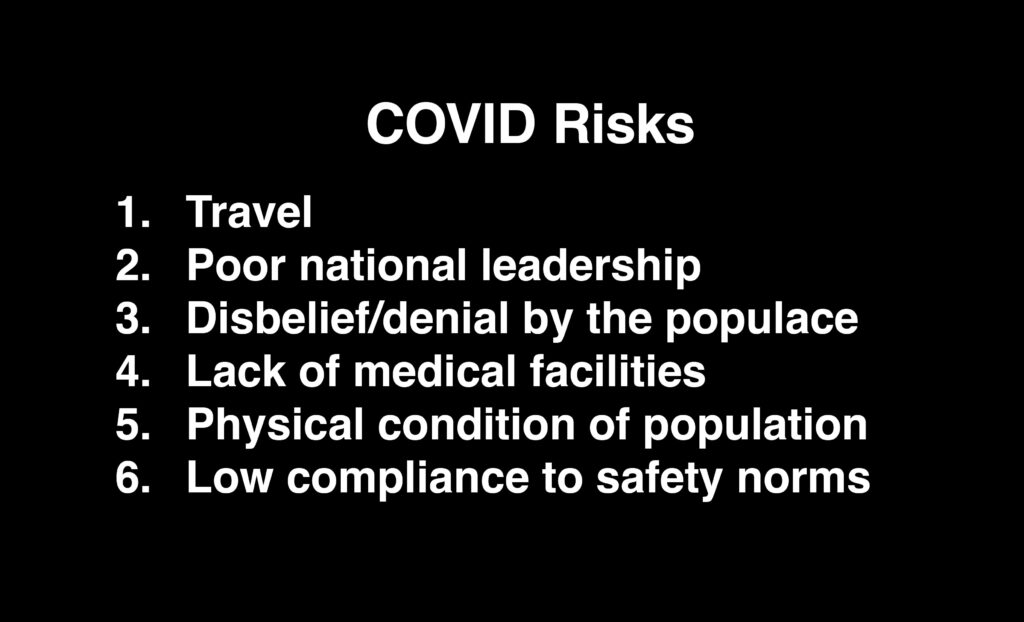Most catastrophes come about through the concurrence of a number of errors, not just a single one. Our brains like to believe in single causes; our brains have challenges dealing with complexities.

When we hear that an Earthquake on the Iran/Iraq border killed thousands, we resolve to stay away from earthquakes or Iran. But earthquakes happen every day. For a catastrophe and large loss of life, the earthquake needs to create a landslide, or crumble poor construction in over populated areas, too many poorly built dwellings near the landslide area, no restriction on building requirements, etc. Those things, and more, add up to a catastrophe.
It is not usually the event itself (the earthquake) that causes the loss of life, but the dominos of other smaller mistakes that cumulate to create the disaster.
When we look at the impact of COVID19 around the world, we see regions where there was almost no effect. No landslides, no poorly built housings, no lack of restrictions near the earthquake danger zone. Countries like Taiwan, New Zealand, Singapore, Japan, much of central Africa, even China, had few deaths, few infections. Why?
Like the earthquake, the cause of death was not the COVID event itself, but how the event was managed and the underlying conditions in the regions. In contrast, the Ebola event a few years ago was well controlled.
My risk analysis friend who identifies factors that cause insurance losses, might identify the following factors as contributors to deaths from COVID19:
- Travel
- Poor national leadership
- Disbelief/denial by the populace
- Lack of medical facilities
- Physical condition of population
- Low compliance with safety norms once communicated.
You will notice that masks, social distancing, quarantining, avoidance of crowds, social pressure to comply are not on that list. They are remedial actions, prophylactics, that require one of the factors above to invoke them. They are at the bottom of the list, part of compliance with safety norms.
The U.S. performed the worst in the world at managing COVID and continues to do so. Should we add “for profit healthcare” to the U.S. factors? How do these factors create an anomaly in a country that could have been exemplary but failed so miserably with huge losses of life?
First, there is a high level of travel in and out of the U.S. We are told COVID first arrived from Europe on the east coast as well as from China on the west coast.
U.S. leadership insisted on denial and minimizing the risk. They were late in understanding the impact and even then continued to deny the problem. National leadership deferred to states and local authorities to initiate measures to reduce the impact. Since travel within its territory was open, the virus hitched a ride with the human movement within the country to spread.
Influencing the leadership’s reticence was the undue importance of the consumer society on the economy in the U.S. where a high proportion of the GDP is reliant on consumer spending. This led leaders to refrain from closing down the economy. So COVID was aided by leadership denial, mixed messages, jurisdiction confusion and the economy’s reliance on consumerism.
The U.S.’s dismal performance also needed cultural arrogance, disbelief in leadership and self deceptions. There was the promised vaccine, herd immunity, any excuse not to accept the overall vulnerability. In short, COVID was not taken seriously as a threat by a significant percent of the population, even a year into it. Houses were built on the sides of a volcano.
We heard the U.S. brag “we have the best healthcare system” as a rationale for taking no efforts. Bragging is like making offerings to the volcano gods. It won’t stop the eruption.
While there is good healthcare in the U.S., the wave of infections overwhelmed it, particularly in minority areas where economic disparity made them vulnerable.
While we have not seen analysis of contributing factors for death, but the high levels of weakening diseases like obesity, diabetes, respiratory and heart conditions may well have contributed to the overall death toll. The U.S. has a much higher level of these than most countries.
Compliance with the need to take prophylactic actions was very high is countries like Taiwan, Singapore and China, perhaps learned from previous epidemics. It mitigated the spread quickly. In the U.S. this never happened. There is still push back, sometimes aggressive, based on the cultural position “you can’t tell me what to do! I’ve got my rights!.” That arrogance brought a lot more deaths.
We still hear disbelief in the U.S. talking heads on news who hesitate to admit the unmitigated disaster is occurring. Fingers point everywhere else. That’s the problem. There is no coherent assessment of the deeper problems that created the opportunity for COVID to kill. Slowly this is changing; hopefully with new leadership it will be better understood.